Erebuni › Saint Gregory the Illuminator » Ancient origins
Articles and Definitions › Contents
- Erebuni › Antique Origins
- Saint Gregory the Illuminator › Who Was
Ancient civilizations › Historical and archaeological sites
Erebuni › Antique Origins
Definition and Origins

Erebuni was an Urartian fortress and city, located between the Nor Aresh District and the Vardahsen District on the outskirts of present-day Yerevan, Armenia, and situated on top of Arin Berd hill. In Armenian, the fortress and archaeological site is known as “Arin-Berd” or the “Fortress of Blood,” and the name of this fortress city endures in the word “Yerevan,” which is the capital of Armenia. First constructed during the reign of Arguishti I (r. 786-764 BCE) around the year 782 BCE - some 20 years before the founding of Rome - Erebuni is typically described by historians and archaeologists as one of the mightiest and most impressive Urartian structures in existence.
Erebuni became the primary residence of the Urartian royal family, and thus emerged as a settlement of political and cultural importance in the Near East. Following the collapse of the Urartian states in the early 6th century BCE, Erebuni retained much of its population and importance as the capital of the Persian Satrapy of Armenia under the Achaemenid Empire by the end of the 6th and early 5th centuries BCE. Its strategic location ensured the city's survival as a political and administrative center under independent Armenian kings in antiquity, and the site has been continually inhabited since its founding, expanding further as it developed into the medieval and modern city of Yerevan.
ARGUISHTI I BROUGHT 6,600 CAPTIVES FROM HATTI & SUPANI TO EREBUNI TO HELP POPULATE THE CITY.
HISTORICAL OVERVIEW
Erebuni was the first Urartian fortress constructed north of the Araxes River in the Armenian highlands, and it owes its genesis to the ambitions and martial appetites of Arguishti I who was the sixth king of Urartu. Arguishti I, the archrival and nemesis of Shalmaneser IV of Assyria (r. 783-773 BCE), was responsible for expanding Urartian power and influence into Asia Minor, the Caucasus, and even what is present-day northern Syria. Urartian power reached its zenith during Arguishti's reign, and Erebuni is a testimony in monumental form to his aspiration of projecting Urartian might and power. Needing to secure and delineate political power throughout his domains, Arguishti I ordered the construction of two major fortresses in what is present-day Armenia: Erebuni in 782 BCE and Argishtikhinili in 776 BCE. Rusa II (rc 680-639 BCE) continued this policy by building Teishebaini in the mid-7th century BCE. Unlike neighboring polities in Asia Minor and the Near East, Urartu had localized, political traditions characterized by networks of interlinked and interspersed fortresses rather than massive urban settlements. Uratian kings, like Arguishti I, hoped that compact and strategically positioned fortresses like Erebuni would be able to withhold sieges from large foreign armies and prevent their penetration of the Urartian interior.

Cuneiform Inscription of Arguishti
During the Urartian period, Erebuni emerged as a political and cultural center while Argishtikhinili, located 5 km (3 miles) north of the Araxes River and 15 km (9 miles) from modern day Armavir, Armenia, developed primarily into an economic center.According to cuneiform inscriptions found at Erebuni and in Van, Armenia, Arguishti I brought 6,600 captives from Hatti and Supani to Erebuni to help populate the city. (This is attested by cuneiform inscriptions in Van and also those found by Soviet excavators while Armenia was part of the USSR.) Although the fortress and city remained affluent, Arguishti I's military prowess was never matched by his successors.
PERSIA UNDERTOOK LARGE-SCALE RECONSTRUCTIONS OF THE FORTRESS & EREBUNI BECAME THE CAPITAL OF THE PERSIAN SATRAPY OF ARMENIA.
Faced with Assyrian, Cimmerian, Scythian, and Median enemies, Urartu declined in the 7th and 6th centuries BCE. Despite being raided by Cimmerian forces and the transference of much of its populace and wealth to the Teishebaini fortress, the Erebuni fortress survived and was occupied by the Median Empire around 585 BCE. Due to its prime geographical location, Erebuni became a flourishing political center once again, albeit under the control of the Persian Achaemenid dynasty (550-330 BCE). The Persians undertook large-scale reconstructions of the fortress and Erebuni became the capital of the Persian Satrapy of Armenia. Despite the fact that Persian power collapsed due to the conquests of Alexander the Great (r. 332-323 BCE) in the 4th century BCE, the settlement at Erebuni continued to grow, eventually spreading outwards from the fortress' ancient walls. Artaxata replaced Erebuni as an Armenian capital around c. 188 BCE.
ARCHITECTURE
Situated on the Arin Berd hill and occupying a space of nearly 40 hectares (99 acres), Erebuni offered commanding views of Mount Ararat and access to the fertile Ararat Plain. The citadel of Erebuni occupies nearly 3 hectares (7 acres). Surrounded by defensive walls - in parts up to 15 m (49 ft) in height and 3-4 m (10-13 ft) in width - Erebuni was accessible from an eastern entrance, which offered strategic views of the three-range defensive walls in addition to the Ararat Plain. The main road that led to the citadel rose from the southeastern slope of the hill at a height of 2 m (6.5 ft) and terminated at the fortress' entrance.The entrance walls contained two cuneiform inscriptions:
By the greatness of Gold Chaldis, Argistis, son of Menuas, built this mighty stronghold and proclaimed it Erebuni. The land was desert. For the glory of the country of Biainili and for holding the enemy's countries in awe, by the greatness of God Chaldis, Argistis, son of Menuas, mighty king, king of the country or Biainili, ruler of the town of Tushpah.
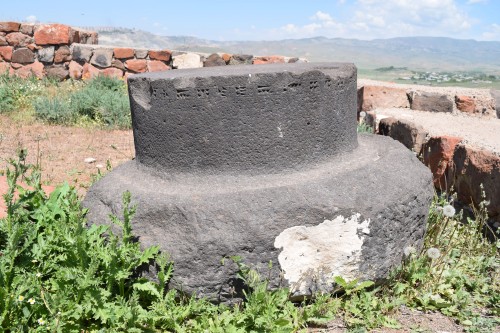
Basalt Pillar with Cuneiform, Armenia
It is likely that the citadel's monumental gate was solid and wooden, and opened to a large central square, which in turn was oriented from the southeast to the northwest. Special sections of the Erebuni fortress served different administrative, residential, and religious purposes: southeast of the main square was the religious section of the fort, including the temple of the Urartian god Khaldi; northwest of the square was occupied by the royal palace, administrative offices, and a temple dedicated to the Urartian god Ivarsa; and to the northeast of the square were residential homes and commercial buildings.Archaeological remains indicate that a ziggurat may have existed on the site too.
The royal palace at Erebuni was especially splendid according to the archaeological remains that have since been uncovered.Archaeologists have determined that the Persians made alterations and reconstructed parts of the administrative complex in the 6th century BCE. Originally, it contained a great hall decorated with frescoes of human figures and natural scenes with wild animals painted in rich hues. After the reign of Sardury II (r. 764-735 BCE), archaeologists suspect that the great hall of the royal palace was turned into a cellar, filled with enormous water and wine jars that could hold up to 40,000 liters (10,567 gallons) worth of liquid. Archaeologists have also uncovered five basalt pillars in the southeastern section of the fortress, which contain inscriptions dating to the reign of Arguishti I. It is believed that a powerful earthquake occurred during the reign of Rusa II, which destroyed parts of the city and palace.
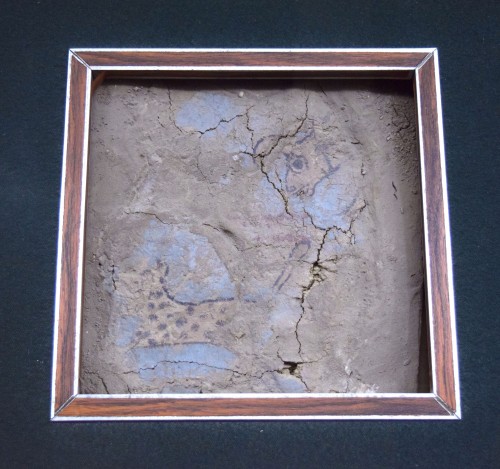
Running Leopard of Erebuni
Khaldi's temple was also decorated with beautiful frescoes, but the Persians later modified the basic temple plan into a rectangular plan during the 6th century BCE. The Persians additionally converted one part of the temple into a pillared hall (apadana). There was a fire temple at Erebuni, and contrary to what would have been considered proper by the Achaemenids, the Armenians sacrificed horses to the sun god, according to the Greek historian Xenophon (c. 430-354 BCE).
EXCAVATIONS & IMPACT ON ARMENIAN CULTURE
The first major excavations at Erebuni began in 1950, under the archaeologist K. Hovhannisyan. A series of Soviet archaeological excavations lead by Konstantin Oganesyan in 1961 and 1969 CE later uncovered most of the artifacts that one sees today in the Erebuni Historical and Cultural Reserve. These excavations revealed a substantial and rich array of cereal and botanical materials preserved after thousands of years. (Archaeologists uncovered grape seeds, sesame oil, lentils, pea, and malted barley for the brewing beer.) Sadly, the massive restoration project of Erebuni fortress in the 1970s CE, which coincided with the 2,750th anniversary of its establishment, did irrevocable harm to the site and its integrity.
Since the collapse of the USSR in 1991 CE and the beginning of hostilities between Armenia and Azerbaijan, there were fewer investigations of the site in the 1990s and early 2000s CE. Recent excavations have focused on Erebuni's later occupations under the Medians, Persians, and Greeks. The imprint of Erebuni on the culture and popular imagination of modern Armenia is undeniable and ubiquitous. The names, symbols, and artifacts associated with Urartian heritage and art have become commonplace as is evidenced by decorative items and company advertising.
This article was made possible with generous support from the National Association for Armenian Studies and Researchand the Knights of Vartan Fund for Armenian Studies.
MAP
Saint Gregory the Illuminator › Who Was
Definition and Origins
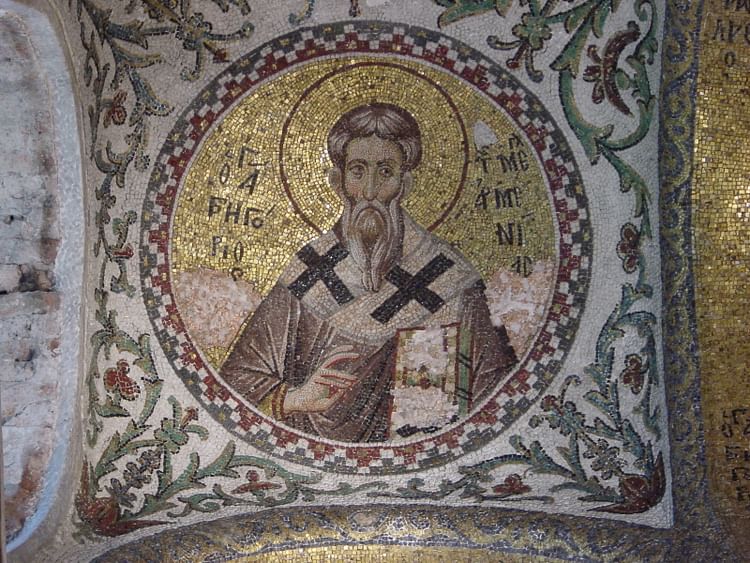
Saint Gregory the Illuminator or Enlightener (previously known as Grigor Lusavorich, c. 239 - c. 330 CE) was the first bishop of the Armenian church, and he is widely credited with converting king Tiridates the Great to Christianity, formally establishing the Armenian Church, and spreading that religion throughout his country. Saint Gregory is the patron saint of Armenia.
EARLY LIFE
The life of Saint Gregory was first recounted in a biography dating to c. 460 CE and the more or less contemporary History of the Armenians by Agathangelos. The saint's original name was Grigor Lusavorich, and he was born in Cappadocia between 239 to 257 CE (dates disputed due to conflicting sources). He was the son of Anak Partev the Parthian, who, being in the pay of the rival Sasanian Empire in Persia (224-651 CE), infamously murdered the Armenian king Khosrov of Kadj. The Lusavorich family was both wealthy and influential but they were all wiped out by the revenging relatives of Khosrov.Fortunately for Gregory, he, the sole survivor of the purge, was whisked away by his nanny to the safety of Cappadoccia.
GREGORY WAS IMPRISONED, TORTURED & THROWN INTO THE TERRIBLE KHOR VIRAP PRISON AT ARTASHAT - KNOWN AS THE “PIT OF OBLIVION”.
Gregory was raised as a Christian and attended a Greek Christian school. On returning to Armenia, Gregory gained a position as a palace functionary at the court of the Armenian king at Vagharshapat. There he made a stance against the pagan religion of the period and refused to participate in its rites. The reigning monarch was Tiridates IV (Trdat III or IV), or Tiridates the Great as he would become known (rc 298 to c. 330 CE), and he had the troublesome Gregory imprisoned, tortured, and thrown into the terrible Khor Virap prison at Artashat. Known as the “pit of oblivion”, nobody ever returned from Khor Virap.
CONVERSION OF TIRIDATES THE GREAT
After a 13-year ordeal down in the pit, Gregory was given a miraculous lifeline by, of all people, Tiridates' sister Khosrovidukht.She had had a vision that the only person who could save the king from his terrible illness (lycanthropy), the symptoms of which were to behave like a wild boar, was Gregory. This was especially ironic as the illness had only come on following the king's orders to murder a group of Christian nuns who had fled persecution in Rome. Accordingly, Gregory was freed from Khor Virap and, naturally, besides trying to cure the king, he made his best efforts to convert him to Christianity.
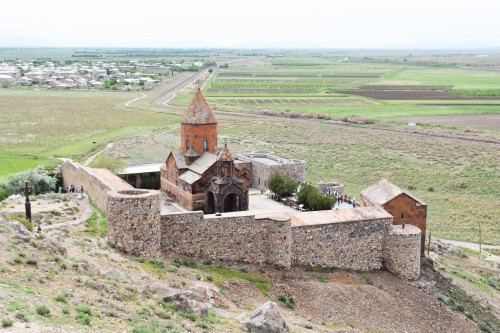
Khor Virap Monastery
Tradition (and the Armenian Apostolic Church) records that Tiridates was cured and converted to his new faith in 301 CE by Saint Gregory. However, modern historians prefer the more secure date of around 314 CE following Roman emperorConstantine I ’s Edict of Milan in 313 CE which legalised Christianity in the Roman Empire. It seems probable that Christianity actually entered Armenia by two separate but more or less contemporary routes, thus explaining the conflicting accounts in ancient historical records. Saint Gregory represented the transmission via Greek culture in the capital while in the provinces a greater influence came from Syria, especially via the Armenian communities in the cities of Mtsbin and Edessa in Mesopotamia. Thus, the spread of the religion was much slower, more organic and haphazard than ancient sources present.
However precisely it happened, and which part is legend and which part fact, Armenia did become a Christian state, and it was a momentous moment in the country's history as the historian RG Hovannisian here explains:
The conversion of Armenia to Christianity was probably the most crucial step in its history. It turned Armenia sharply away from its Iranian past and stamped it for centuries with an intrinsic character as clear to the native population as to those outside its borders, who identified Armenia almost at once as the first state to adopt Christianity. (81)
THE SPREAD OF CHRISTIANITY
Gregory was made the first bishop ( katholikos ) in Armenia's history in Caesarea in Cappadocia, again c. 314 CE, and he set about formally establishing the Christian Church as soon as he returned to the kingdom of Armenia. To get the ball rolling Tiridates gave Saint Gregory up to 15 provinces worth of territory to establish the Armenian Church. The old pagan temples were torn down, Zoroastrian sites were converted to Christian ones, and the whole nation was obliged to embrace the new faith. Churches and monasteries sprang up everywhere, including at the Khor Virap, Gregory's home for so long, which was eventually converted into a monastery. The Armenian aristocracy quickly followed the royal family's example and many noble families converted to Christianity.

Arsacid Armenia
Armenia had long been fought over by Rome and Persia as it stood between those two great empires of the period. Although the adoption of Christianity shifted Armenia closer to Roman religious culture, one consequence of the move was that the persecution of the religion by Persia helped to create a more fiercely independent state. The Sassanid Empire had been trying to impose Zoroastrianism on its neighbours and Christianity was a means to resist Persian political and cultural imperialism. Rome, on the other hand, saw the value in permitting the spread of Christianity as a means to maintain Armenia's independence from Persia.
SAINT GREGORY USED TWO PRINCIPAL METHODS TO SPREAD CHRISTIANITY IN ARMENIA: EDUCATION & MILITARY POWER.
Tiridates the Great may also have adopted Christianity for internal political reasons - the end of the pagan religion (with its heady mix of Greek, Persian, Semitic, and local gods) was a fine excuse to confiscate the old temple treasuries which were jealously guarded by a hereditary class of priests. Further, a monotheistic religion with the monarch as God's representative on earth might well instil greater loyalties from his nobles and people in general. As it turned out, the Armenian Church became an independent institution with noble families providing its key figures and monasteries able to achieve self-sufficiency through their own landed estates.
EDUCATION & WARFARE
Saint Gregory used two principal methods to spread Christianity in Armenia: education and military power. Schools were established in which children of the existing pagan priestly class were prepared for the Christian priesthood. Meanwhile, military units were dispatched to destroy pagan temple sites and confiscate their vast riches, which were then used to fund Christian building projects. Naturally, many temple sites, along with several rich and semi-independent feudal principalities, resisted the new policy and these were put to the sword. Gregory oversaw mass baptisms in the Euphrates River; bishops were then appointed from the noble clans ( nakharars ) and lower priests from the class of knights ( azats ) to guide the ever-growing flock of faithful.
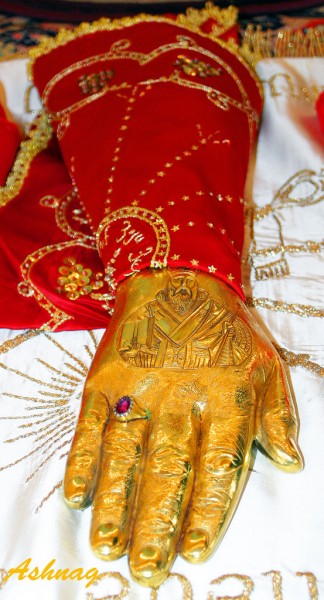
Right Hand of Saint Gregory the Illuminator
Gregory established his new headquarters at Ashtishat. The most important ancient temple site in Armenia, Ashtishat was a symbol of the new order and chosen by Gregory as a result of a vision in which he realised that Jesus Christ had descended to earth at that very spot. There a monastery was built, the Surb Karapet with its shrine to Saint John the Baptist. The monastery would remain an important site of Christian pilgrimage for 16 centuries until its destruction in 1915 CE.
RETIREMENT & SUCCESSORS
Later in life Gregory retired to the seclusion of the cave of Mane in northwestern Armenia where he lived as an ascetic.Gregory died there of old age sometime between 325 and 330 CE. The former bishop's remains were buried at Tordan on the Euphrates River in the western province of Daranaghik, although later his bones would become prized relics in various churches across the country.
The descendants of Gregory carried on his work, notably his younger son Aristakes, who, known for his asceticism, was the next bishop (the office was hereditary) and who attended the First Ecumenical Council of Nicaea in 325 CE. When Aristakes died in 333 CE, Gregory's other son Vrtanes became bishop, a role which passed to his son Husik I c. 341 CE. There would be several more descendants after that, many of whom were made saints, as their founding father Gregory had been. Saint Gregory had many monuments built in his honour but perhaps the most celebrated was the cathedral at Ani built by the great architect Trdat for King Gagik (r. 1001-1010 CE).
This article was made possible with generous support from the National Association for Armenian Studies and Researchand the Knights of Vartan Fund for Armenian Studies.
LICENSE:
Article based on information obtained from these sources:with permission from the Website Ancient History Encyclopedia
Content is available under License Creative Commons: Attribution-NonCommercial-ShareAlike 3.0 Unported. CC-BY-NC-SA License